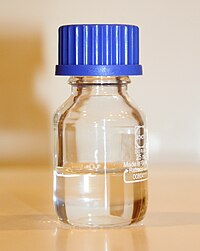
Photo from wikipedia
The supramolecular interactions between 1,3-bis(4-pyridyl)azulene (azbbpy) as a hydrogen bond acceptor and a variety of aromatic hydrogen-bond donors produced new binary molecular co-crystals and a salt. All crystal structures display… Click to show full abstract
The supramolecular interactions between 1,3-bis(4-pyridyl)azulene (azbbpy) as a hydrogen bond acceptor and a variety of aromatic hydrogen-bond donors produced new binary molecular co-crystals and a salt. All crystal structures display extensive and very complex hydrogen bond networks containing both homo- and heterosynthons formed through robust O–H⋯N and OH⋯O hydrogen bonds. The binary co-crystals of azbbpy with 4,4′-biphenol and 4,4′-oxo-bis-benzoic acid in a 1 : 1 ratio revealed that the recognition process differs. While 4,4′-biphenol acts both as a donor and an acceptor of protons, generating a two-dimensional supramolecular network in which azbbpy interacts with only one pyridine moiety, the co-crystallization with 4,4′-oxo-bis-benzoic acid yielded zig-zag chains formed by alternating acid–pyridine supramolecular heterosynthons. Co-crystallization with isophthalic acid yields a 2 : 1 system, 4, as hydrogen-bonded zig-zag supramolecular chains containing a R44(36) graph set organized through strong OH⋯N and weak C–H⋯N hydrogen bonds. Co-crystallization of azbbpy with trimesic acid in different ratios yielded two distinct systems: co-crystal 5 and salt 6. In 5, the trimesic acid molecules are assembled in supramolecular helical chains which are further connected by azbbpy through hydrogen bonding and π–π interactions into a 3D architecture with channels that host water molecules. A complicated supramolecular 3D architecture is also established between trimesic anions and azbbpyH+ cations in crystal 6, resulting in channels filled with disordered solvent molecules. These types of interactions were also evidenced in a quantitative way and confirmed on grounds of the Hirshfeld surface mapped with geometrical parameters that characterize close contacts in co-crystals. The optical properties of these supramolecular systems showed strong absorption bands in the visible region due to the azulene fragment.
Journal Title: CrystEngComm
Year Published: 2018
Link to full text (if available)
Share on Social Media: Sign Up to like & get
recommendations!